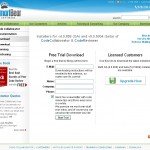This is part 2 of a 5-part series: How to convert more software trials to purchases.
There are three camps about asking for contact info before a trial starts:
A. Ask for nothing – Maximize number of downloads; minimize barriers.
B. Show 1 – 4 fields – Make them optional. Get what you can, then get out of the way.
C. Show 14 fields – Get their street address. Only serious people will download so you don’t waste your time with crap trials.
Allow me to convince you that B is the way to go.
Let’s first dispense with C.
If the world of free social media has taught us anything, it’s that “invasion without permission” is dead. You haven’t earned people’s contact information so they won’t give it.
Most people will give you crap data. No, scratch that, most people will roll their eyes at your marathon form and close their browser, moving on to your competitor’s website they have on hot standby in the adjacent tab. Besides, what do you need with all that data? Mailing address? Really? You’re going to send them a holiday card?
Oh, you need lead-routing info for your sales reps? Fair enough, but consider this: If you just ask for postal code and country, you can fill in city, state/province, and all that other stuff. Why accost your potential customer with something you can do yourself?
Don’t make your trial a chore; you’ll just fulfill your misguided goal of having as few downloads as possible while simultaneously starting the trial experience on a sour note.
Now let’s consider option A.
The idea of “remove all barriers to trial“ makes sense, and certainly this extreme is better than C. I used to believe A was the only way to go, but let me tell you the story of trial downloads at my company, Smart Bear. For years, downloads were freely available with no form to fill out. Life was good; no one complained.
Why B (1 – 4 optional fields before a trial starts) is the way to go?
We did a little experiment. What would happen if we introduced just a few, optional fields? Who cares if people skip them, who cares if people fill in crap – as long as we get some good data from people who want to share it and there’s no drop in the number of downloads, it’s a win.
While we’re at it, let’s make it easy for existing customers to skip the form completely. To further err on the side of convenience, let’s not even care if trial customers skip the form too!
Here’s what we built:
The result? There was no change in the number of downloads! In fact, every month since starting this in Jan 2008 we’ve seen a steady increase in number of downloads. (Of course the subsequent increase is attributable to marketing efforts; the point is that the presence of the fields has never been a deterrent.)
The “optional” nature of the fields is crucial. If people don’t want to tell you – and most won’t – that’s OK and you don’t want to stop a download. Better to download in silence than to not download! But you’ll be surprised how many do want to talk to you.
But this is just half the story. The other half is the hidden fields that we include in that form. All automatic, nothing evil, nothing that would bother a user, but really useful stuff.
1. The first trick helps us with marketing.
When a user first comes to our site – on any page – we give them a cookie that stores the referring link. We don’t change that cookie as the user navigates the site or even closes the browser and returns later. Then in the download form we stuff that “initial referring page” into a hidden field. Now for every download you know which website originally lead this user to your website!
2. The second trick helps us with sales.
Remember those sales reps that needed routing info? You can (more or less) do that with IP address geo-coding.
Now before you protest, yes I agree that you can’t always determine someone’s location from IP address. There are firewalls, proxies, corporate networks, and other reasons why IP address isn’t enough to pin someone’s physical location. But for general information, for an initial attempt at lead-routing, it’s good enough.
And most importantly, it’s free to collect it without bothering the user.
I don’t want to endorse any particular service, but some ways to do it are the Google API and various commercial offerings. In any case, you would query the info using Javascript/AJAX and populate hidden fields with city, state, and country.
3. The third trick is to appreciate returning customers and help them out.
Sure they might notice the “returning customers click here” section, but they might not (or you might not like the idea of having the choice).
To help them, give each user a cookie containing the field values they typed in last time, and pre-populate the form with that cookie when they visit the page again. This also makes it easy to see when someone downloads multiple times, especially if you also generate a GUID in a hidden field and repeat that as well.
So the bottom line is:
Collect some data, in a way that doesn’t disrupt the user, and collect as much data automatically as you can. You won’t stop downloads and you’ll get a ton of useful information.






